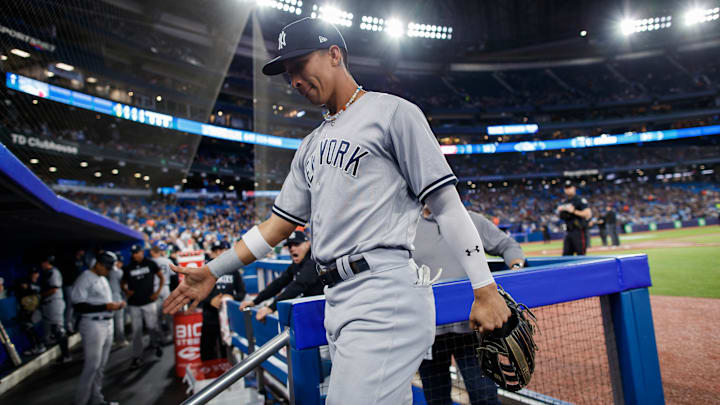In Game 1 of the ALDS between the New York Yankees and Cleveland Guardians, Oswaldo Cabrera batted fifth and played left field. Cabrera became the first rookie position player to start in the postseason since Gleyber Torres and Miguel Andujar in 2018 – a true testament to his performance since getting promoted.
Despite making his major league debut on Aug. 17, when the outfield desperately needed a spark, Cabrera was the Yankees’ third most valuable outfielder by Fangraphs’ Wins Above Replacement (fWAR), trailing only Aaron Judge and Matt Carpenter. In 44 games, Cabrera hit .247/.312/.429 (111 wRC+) with a whopping 13 Defensive Runs Saved across six different positions.
However, in 2023, Cabrera has been one of the worst players in Major League Baseball. Among position players with at least 150 plate appearances, Cabrera’s -0.6 fWAR is 201st among 206 players. Due to his poor performance as well as Josh Donaldson and Giancarlo Stanton returning from the IL, the Yankees optioned Cabrera to Triple-A before their series against the Dodgers.
Then, without giving him any chance to work on his swing and cultivate change, they promoted him to take Greg Allen's place. He homered, seemingly seconds after touching down in Hollywood en route from the Newark airport. Baseball's a funny game. But his problems aren't solved.
While Cabrera’s defensive versatility and base running are MLB-caliber, the struggling sophomore must work on these three offensive areas if he wants to make it back to the Bronx permanently.
Cabrera needs to pull pitches effectively
When MLB players pull batted balls into play, they tend to have more success than when they hit them up the middle or to the opposite field. Among the three batted ball outcomes, pulling leads hitting the ball up the middle and the opposite field in AVG, SLG, OPS, ISO, wOBA and wRC+ by wide margins.
Even though Cabrera pulls 45.2% of the balls he puts into play, his 13 wRC+ when he pulls the ball ranked 276th among 280 players who have pulled at least 30 balls in 2023 at the time of his demotion.
In 2022, Cabrera’s .182 ISO was above the league average by .030 points. This, in large part, was due to how successful Cabrera was when he pulled the ball. Of the six home runs he hit, five of them were pulled, leading Cabrera to have a 205 wRC+ and .436 ISO when he pulled the ball.
With his struggles pulling the ball in 2023, Cabrera’s ISO is down .085 points to .097, 177th among 206 players with at least 150 plate appearances. In order to recapture his offensive success from his rookie season, Cabrera must work on fixing this aspect of his game.
Cabrera needs to start barreling the ball
In addition to pulling the ball, Cabrera needs to improve his quality of contact. His .240 expected weighted on base average (xwOBA) is .240, ranking in the first percentile. Cabrera’s .236 actual wOBA is right in line with his xwOBA, ranking in the second percentile.
While there are outliers in both directions, xwOBA and wOBA are typically correlated, and in order for a player to improve their xwOBA, barreling the ball is a helpful start.
For Cabrera, finding barrels has been a struggle, as his 4.0 barrel percentage ranks in the 16th percentile. According to Baseball Savant, the r2 between ISO and barrel% is 0.62, meaning that approximately 62% of the variance in ISO can be explained by barrel% – a rather strong correlation.
Cabrera’s biggest flaw this season has been his inability to hit for power. However, if he can start consistently barreling pitches in Triple-A, he should have significantly better results at the plate.
Where have Cabrera's line drives gone?
While it’s important for players to barrel the ball, barrels are usually insignificant if the ball is popped up or grounded directly to a defender. Sixty percent of the balls that Cabrera put into play this season have either resulted in ground balls or infield fly balls.
However, when Cabrera hits line drives, he has a 488 wRC+ this season. The problem, though, is that Cabrera only hits line dives 11.9% of the time, the fourth lowest percentage among players with at least 150 plate appearances.
This season, Cabrera’s average launch angle is 15.4°, but he isn’t doing much damage on balls he hits into the air because he's rarely barreling these pitches.
If Cabrera changes his approach to try and get through the ball instead of getting underneath it, his 8.1 poor/weak contact percentage, which ranks 16th among 206 players with at least 150 plate appearances, should drastically improve.
